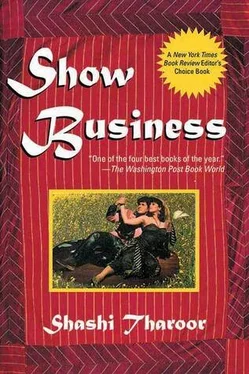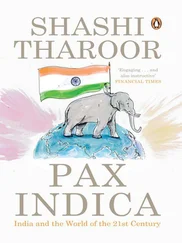There is some discussion, but the party hacks all come down on Ashwin’s side. It has been a long time since I’ve found myself in a collective enterprise where I can’t always get my own way.
The visit to the Guru settled, my sturdy supporters file out, leaving behind their beedi stubs and tea glasses and scraps of paper, the residue of political cogitation in India. Ashwin’s eyes are closing behind his glasses. I feel the time has come to tell him how much I appreciate what he is doing.
“Ash,” I say, recalling a nickname I haven’t used since our school days, “I want to tell you how much I appreciate what you are doing.” And since that doesn’t sound fraternal enough, I gratuitously add, “So all those days I spent playing cricket with you in the backyard are finally paying off for me, hanh?”
He stares at me for a long time, as if debating in his mind whether to say something or not. His better instincts lose the debate. “Ashok,” he says at last, looking me directly in the eye, “you know what my most abiding recollection is of playing cricket with you, my elder brother, role model, and hero? It was you, five years older than me, deciding to bat first, making me bowl for what seemed like hours in the hot sun, and then, just before it became my turn to bat, hitting the ball into the neighbor’s estate so you wouldn’t have to bowl to me. It happened,” he adds levelly as he sees me about to react, “more than once.”
What can you say to a thing like that? I had no idea that my brother had stored up these petty resentments. But my tongue has done enough damage already. I choose to be sensible; for once I say nothing.
The Guru sits cross-legged on a raised dais, his posterior resting on a mattress covered with a dingy white sheet, his back leaning against a pair of lumpy bolsters. He is dressed in a white robe of uncertain provenance, part Arab djellaba and part costumier’s fantasy from Hadrian VII. His balding head is decorated by a cap of even obscurer antecedents, a velvet circle that might have been an Orthodox Jew’s shower cap. The lack of hair on his scalp is more than amply compensated for by the rest of his face, which drips with a lush gray beard that flows in immaculately groomed profusion down his chest. Rings gleam on his fingers, enlightenment in his dark eyes. These are at last open: they have been closed for the last half hour as the Guru meditated, arms stretched out and thumbs tucked into fingers, while Ashwin and I and a host of saffron-clad devotees (themselves, like their master’s attire, of varying and unplaceable origins) sat on the floor and waited reverentially.
The Guru surveys the assemblage, gently lifts a berobed haunch, and breaks wind. An echo seems to follow, but it is only the devotees letting out a collective sigh.
“So, who have we here today?” he asks, casting his gleam in our direction.
“Sir, zese peepul ’ave come to pay zeir rhespects,” says a Frenchwoman in saffron who seems to be the Guru’s principal assistant. “Chri Ashok Banzhara, ’oo his a film hactor from Bombay, and ’is brozer. Chri Banzhara,” she adds disapprovingly, “his also a political candidate in ze helections ’ere.” Some curious heads turn in my direction.
The sage’s beady eyes light up, their black pupils luminescent with interest. “Ah, friends from the cinema world,” he announces. “A most interesting domain, and how like our religion, is it not?” He seems to expect no answer, and I wonder if it is now my turn to make social chitchat. As I prepare to rise to my feet to greet him, I feel Ashwin’s restraining hand. “Wait till after the discourse,” he whispers. That’s right, of course: the Guru has to address the assembled faithful, as he does at this hour every morning, and then we might find it possible to present ourselves. It is said that the Guru chooses the subjects for his sermons upon opening his eyes after meditation. That certainly seems to be the case today.
“Indian cinema has many remarkable affinities to Indian religion,” he intones to my astonishment, gazing into the distance as if at some great TelePrompTer in the sky. “Hinduism, as I have explained before, is agglomerative and eclectic: it embraces and absorbs the beliefs and practices of other faiths and rival movements. It coopts native dissenters — Buddha, Mahavira — and plagiarizes foreign heresies, finding the Protestant work ethic, for instance, in the karma-yoga of the Bhagavad Gita. The Hindi film is much the same: it borrows its formulas from Hollywood, its music from Liverpool, and its plot lines from every bad film that Hong Kong has ever produced. The moment an Indian director, a Mrinal Sen or a Benegal, makes a well-regarded serious film, he is promptly seduced into the industry before he can constitute a threat to it from outside — rather as Buddhism and Jainism were reabsorbed into Hinduism in our country. But the underlying philosophical premise is even more absolute. For just as the Hindu notion of time runs cyclically, repeating itself endlessly, so also Hindi cinema consists of endlessly repeated variations on a few basic themes. The Indian film is the idealized representation of the Indian attitude to the world.”
“Outrageous nonsense,” I whisper to Ashwin. He shushes me with a warning finger to his pursed lips. The Frenchwoman looks disapprovingly back toward us. I notice that she is uncommonly pretty and that under her thin cotton robe she is braless.
“I have described to you in an earlier discourse the challenge that Hindu philosophy offers to the notion of a duality between God and man, between the Creator and His creations. In the Upanishads, the ultimate goal of the believer is the realization of his Oneness with the Absolute. All of us, all of you, are one with God; God is within you, and you are within Him, or It.
“Aha, you might say, then how is God portrayed in so many different forms, as blue-skinned Krishna, as bow-carrying Rama, as elephant-tusked Ganapati, even as female, in the forms of so many divine goddesses? There is a simple answer. The Supreme Being, the essential First Cause of our creation, is visualized in a variety of forms because of our weakness — our inability to worship the divine without personifying it. It is our avidya, our ignorance, that prevents us from grasping the essence of divinity, hence the need to depict the First Principle in forms more comprehensible to humans. This became particularly important in spreading religious belief to the masses, the ordinary people who wanted to worship specific divine qualities such as the ability to make rain, the power to destroy evil, the conferring of good fortune. Instead of bestowing all these functions on one Supreme Being, Hinduism ascribes different names to different manifestations of God, each with his or her own characteristics, duties, and, shall we say, heavenly talents, all just to make divinity more accessible. Thus we have Sarasvati the goddess of learning, Kali the goddess of destruction, Rama the warrior-king of righteousness and justice, and so on.
“Now is this not also what the Hindi film does? In all Hindi films there is only one theme: the triumph of good over evil. The actual nature of the evil, the precise characteristics of the agent of good, may vary from film to film. The circumstances may also change, as do the stories in our Puranas. The songs vary, as do our religious bhajans. But there is no duality between the actor and the heroes he portrays. He is all of them, and all of them are manifestations of the Essential Hero. Therein lies the subconscious appeal of the Hindi film to the Indian imagination and the appeal, along with it, of the Hindi film hero.”
I can scarcely believe how raptly the devotees are taking in this twaddle. Some of them have their eyes closed, in order, I assume, to better experience the ecstasy of the Guru’s words. Other eyes are wide open, as if to admit as much as possible of the sage’s radiance. “This can help us,” Ashwin whispers into my ear, and when the Frenchwoman looks back, I sense a softer expression on her face, and I hope it is because she is beginning to identify me with her Guru’s Essential Hero.
Читать дальше












